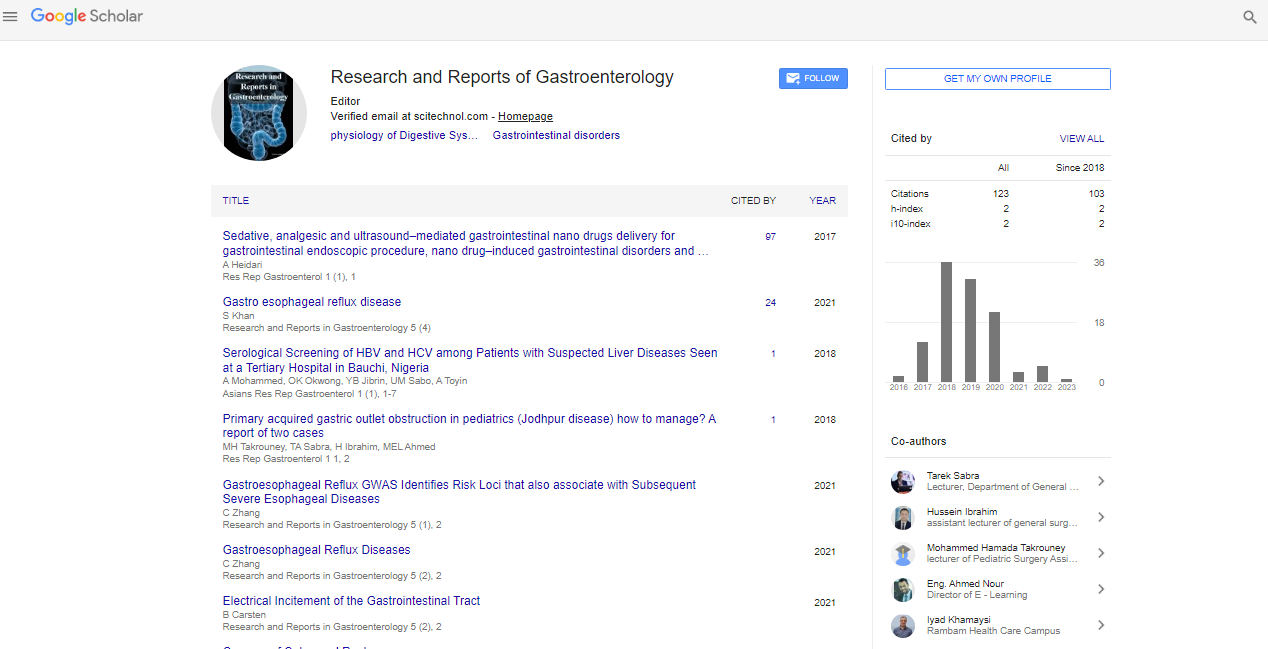Opinion Article, Res Rep Gastroenterol Vol: 7 Issue: 3
Hepatic Encephalopathy: Dissecting the Brain-Liver Connection
Alena Maasoumy*
1Department of Gastroenterology, Hannover Medical School, Hannover, Germany
*Corresponding Author: Alena Maasoumy,
Department of Gastroenterology,
Hannover Medical School, Hannover, Germany
E-mail: maasoumyalena@gmail.com
Received date: 23 August, 2023, Manuscript No RRG-23-118901;
Editor assigned date: 25 August, 2023, PreQC No RRG-23-118901(PQ);
Reviewed date: 08 September, 2023, QC No RRG-23-118901;
Revised date: 15 September, 2023, Manuscript No RRG-23-118901 (R);
Published date: 22 September, 2023, DOI: 10.4172/Rrg.1000150
Citation: Maasoumy A (2023) Hepatic Encephalopathy: Dissecting the Brain-Liver Connection. Res Rep Gastroenterol 7:3.
Description
Hepatic Encephalopathy (HE) is a complex neuropsychiatric syndrome that arises in patients with liver disease, particularly cirrhosis. The intricate relationship between the liver and the brain, as well as the latest research and therapeutic strategies for this condition. Hepatic encephalopathy is a challenging and potentially lifethreatening complication of liver disease, characterized by a spectrum of neurological and psychiatric symptoms. It is most commonly associated with cirrhosis, a late-stage scarring of the liver, but can also occur in acute liver failure or other conditions that impair liver function. This manuscript aims to provide a comprehensive overview of hepatic encephalopathy, its underlying mechanisms, clinical manifestations, diagnostic approaches, and management strategies.
Pathophysiology
The liver plays a central role in detoxifying the blood and metabolizing various substances, including ammonia. In liver disease, especially cirrhosis, impaired liver function leads to the accumulation of ammonia and other neurotoxins in the bloodstream. Ammonia, in particular, crosses the blood-brain barrier and disrupts neurotransmission in the brain. This imbalance of neurotransmitters, particularly Gamma-Aminobutyric Acid (GABA) and glutamate, is a key factor in the pathogenesis of HE.
Hepatic Encephalopathy (HE) is a neuropsychiatric syndrome that can manifest with a broad range of symptoms, from subtle cognitive changes to severe neurological deficits. The clinical presentation of HE can vary from patient to patient, and the severity of symptoms may also fluctuate. Common clinical features of hepatic encephalopathy include:
Asterixis: This is a distinctive feature of HE, often referred to as "liver flap." Asterixis is a flapping tremor of the outstretched hands when the wrist is extended. It is a sign of impaired neuromuscular control and is commonly observed in moderate to severe HE.
Stupor and coma: In severe cases, patients may progress to altered levels of consciousness, ranging from stupor (a state of unresponsiveness but with arousal to stimuli) to coma. Coma is a difficult manifestation of severe HE and requires immediate medical attention.
Diagnosis
Clinical assessment: The diagnosis of HE often begins with a clinical assessment by a healthcare provider. They will evaluate the patient's medical history, including any history of liver disease, cirrhosis, or risk factors for liver disease. They will also assess the patient's neurological symptoms and cognitive function. Observing common clinical features like altered mental status, asterixis (flapping tremor), and impaired cognition is essential in making a preliminary diagnosis.
Liver function tests: Assessing liver function is important to determine the underlying liver disease (usually cirrhosis) and its severity. Elevated liver enzyme levels may be indicative of liver dysfunction.
Ammonia levels: One of the hallmark features of HE is elevated blood ammonia levels. Blood ammonia levels, however, do not always correlate directly with the severity of symptoms. High ammonia levels can be suggestive of HE, but normal levels do not rule it out.
Emerging Research
Ongoing research seeks to uncover the complexities of HE, including the gut-brain axis, the role of the microbiome, and novel therapies targeting specific pathways involved in its pathogenesis. Understanding these mechanisms holds promise for more effective treatments and improved outcomes for HE patients.
Hepatic encephalopathy represents a challenging complication of liver disease, with a diverse clinical presentation. Management should focus on reducing ammonia levels, treating the underlying liver condition, and providing symptomatic relief. The complex interplay between the liver and the brain in HE is an active area of research, offering hope for improved therapeutic strategies in the future. Early recognition and comprehensive management are essential for patients afflicted by this condition.
